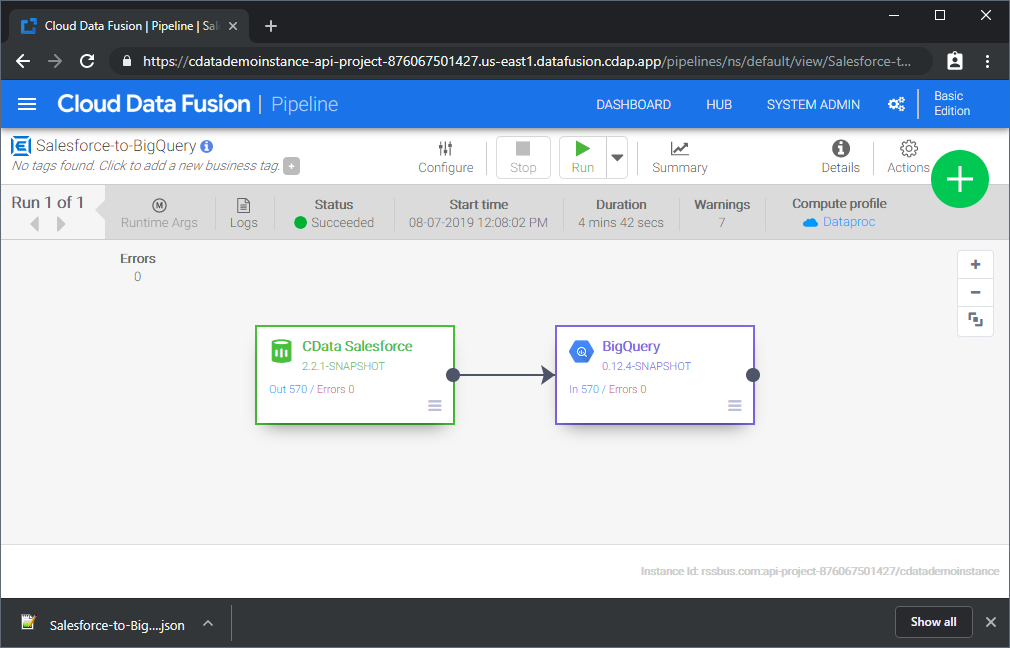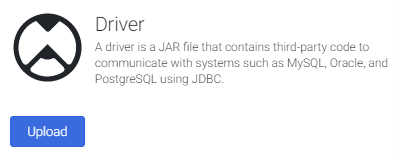Discover how a bimodal integration strategy can address the major data management challenges facing your organization today.
Get the Report →Build SQL Analysis Services-Connected ETL Processes in Google Data Fusion
Load the CData JDBC Driver into Google Data Fusion and create ETL processes with access live SQL Analysis Services data.
Google Data Fusion allows users to perform self-service data integration to consolidate disparate data. Uploading the CData JDBC Driver for SQL Analysis Services enables users to access live SQL Analysis Services data from within their Google Data Fusion pipelines. While the CData JDBC Driver enables piping SQL Analysis Services data to any data source natively supported in Google Data Fusion, this article walks through piping data from SQL Analysis Services to Google BigQuery,
Upload the CData JDBC Driver for SQL Analysis Services to Google Data Fusion
Upload the CData JDBC Driver for SQL Analysis Services to your Google Data Fusion instance to work with live SQL Analysis Services data. Due to the naming restrictions for JDBC drivers in Google Data Fusion, create a copy or rename the JAR file to match the following format driver-version.jar. For example: cdatassas-2020.jar
- Open your Google Data Fusion instance
- Click the to add an entity and upload a driver
![]()
- On the "Upload driver" tab, drag or browse to the renamed JAR file.
- On the "Driver configuration" tab:
- Name: Create a name for the driver (cdata.jdbc.ssas) and make note of the name
- Class name: Set the JDBC class name: (cdata.jdbc.ssas.SSASDriver)
![Configuring the driver (Salesforce is shown.)]()
- Click "Finish"
Connect to SQL Analysis Services Data in Google Data Fusion
With the JDBC Driver uploaded, you are ready to work with live SQL Analysis Services data in Google Data Fusion Pipelines.
- Navigate to the Pipeline Studio to create a new Pipeline
- From the "Source" options, click "Database" to add a source for the JDBC Driver
![Adding a database source]()
- Click "Properties" on the Database source to edit the properties
NOTE: To use the JDBC Driver in Google Data Fusion, you will need a license (full or trial) and a Runtime Key (RTK). For more information on obtaining this license (or a trial), contact our sales team.
- Set the Label
- Set Reference Name to a value for any future references (i.e.: cdata-ssas)
- Set Plugin Type to "jdbc"
- Set Connection String to the JDBC URL for SQL Analysis Services. For example:
jdbc:ssas:RTK=5246...;User=myuseraccount;Password=mypassword;URL=http://localhost/OLAP/msmdpump.dll;To connect, provide authentication and set the Url property to a valid SQL Server Analysis Services endpoint. You can connect to SQL Server Analysis Services instances hosted over HTTP with XMLA access. See the Microsoft documentation to configure HTTP access to SQL Server Analysis Services.
To secure connections and authenticate, set the corresponding connection properties, below. The data provider supports the major authentication schemes, including HTTP and Windows, as well as SSL/TLS.
-
HTTP Authentication
Set AuthScheme to "Basic" or "Digest" and set User and Password. Specify other authentication values in CustomHeaders.
-
Windows (NTLM)
Set the Windows User and Password and set AuthScheme to "NTLM".
-
Kerberos and Kerberos Delegation
To authenticate with Kerberos, set AuthScheme to NEGOTIATE. To use Kerberos delegation, set AuthScheme to KERBEROSDELEGATION. If needed, provide the User, Password, and KerberosSPN. By default, the data provider attempts to communicate with the SPN at the specified Url.
-
SSL/TLS:
By default, the data provider attempts to negotiate SSL/TLS by checking the server's certificate against the system's trusted certificate store. To specify another certificate, see the SSLServerCert property for the available formats.
You can then access any cube as a relational table: When you connect the data provider retrieves SSAS metadata and dynamically updates the table schemas. Instead of retrieving metadata every connection, you can set the CacheLocation property to automatically cache to a simple file-based store.
See the Getting Started section of the CData documentation, under Retrieving Analysis Services Data, to execute SQL-92 queries to the cubes.
Built-in Connection String Designer
For assistance in constructing the JDBC URL, use the connection string designer built into the SQL Analysis Services JDBC Driver. Either double-click the JAR file or execute the jar file from the command-line.
java -jar cdata.jdbc.ssas.jarFill in the connection properties and copy the connection string to the clipboard.
![Using the built-in connection string designer to generate a JDBC URL (Salesforce is shown.)]()
-
HTTP Authentication
- Set Import Query to a SQL query that will extract the data you want from SQL Analysis Services, i.e.:
SELECT * FROM Adventure_Works
![Configuring the database source]()
- From the "Sink" tab, click to add a destination sink (we use Google BigQuery in this example)
- Click "Properties" on the BigQuery sink to edit the properties
- Set the Label
- Set Reference Name to a value like ssas-bigquery
- Set Project ID to a specific Google BigQuery Project ID (or leave as the default, "auto-detect")
- Set Dataset to a specific Google BigQuery dataset
- Set Table to the name of the table you wish to insert SQL Analysis Services data into
![Configuring the BigQuery sink]()
With the Source and Sink configured, you are ready to pipe SQL Analysis Services data into Google BigQuery. Save and deploy the pipeline. When you run the pipeline, Google Data Fusion will request live data from SQL Analysis Services and import it into Google BigQuery.

While this is a simple pipeline, you can create more complex SQL Analysis Services pipelines with transforms, analytics, conditions, and more. Download a free, 30-day trial of the CData JDBC Driver for SQL Analysis Services and start working with your live SQL Analysis Services data in Google Data Fusion today.











